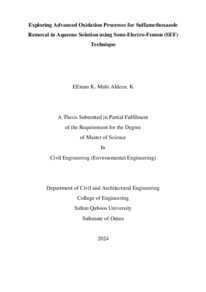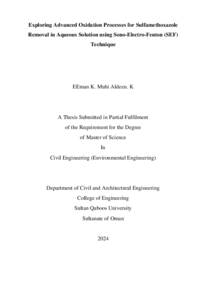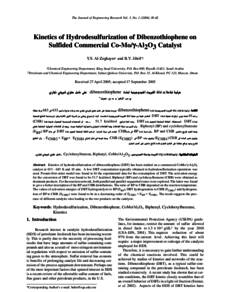Document
Exploring advanced oxidation processes for sulfamethoxazole removal in aqueous solution using Sono-Electro-Fenton (SEF) technique.
Source
Master's thesis
Other titles
اكتشاف عمليات الأكسدة المتقدمة لإزالة السلفاميثوكسازول من المحاليل المائية باستخدام تقنية سونو-الكترو فنتون (SEF)
Country
Oman
City
Muscat
Publisher
Sultan Qaboos University
Gregorian
2024
Language
English
Thesis Type
Master's thesis
English abstract
Pharmaceuticals and personal care products (PPCPs) are emerging pollutants that are
widespread and raise concerns for the environment and human health. Sulfamethoxazole
(SMX), a sulfonamide antibiotic, was the targeted pollutant in this study. The objective
was to evaluate the efficiency of the Sono-electro-Fenton technique (SEF) in removing
SMX antibiotic using potassium persulfate (K2S2O8) in aqueous solution and compare it
with hydrogen peroxide (H2O2). Experiments were conducted under ideal conditions to
remove SMX using the SEF technique. Various factors were assessed to determine the
optimal conditions for SMX elimination using High-Performance Liquid Chromatography
(HPLC) with a constant SMX concentration of 50 mg/l initially. The study determined that
specific pH, oxidant dosage, electrolysis time, and voltage settings were crucial for
effective removal of the antibiotic using the SEF technique. Iron dissolution and energy
consumption were also examined at different voltage levels. The study then tested these
optimized conditions with varying initial concentrations of SMX, finding different removal
efficiencies between K2S2O8 and H2O2, with H2O2 becoming less efficient as SMX
concentrations increased. SMX concentrations were also studied in the presence of ferric
chloride hexahydrate (FeCl3.6H2O) using different ratios with K2S2O8 and H2O2. Results
showed that using the K2S2O8:FeCl3.6H2O (0.8 mL:0.8 mL) ratio resulted in removal
efficiencies of 49%, 77%, 80%, 99%, and 92% for concentrations of 0.5 mg/L, 1 mg/L, 1.5
mg/L, 2 mg/L, and 2.5 mg/L, respectively. Conversely, using the H2O2:FeCl3.6H2O (0.8
mL:0.8 mL) ratio led to 99%, 98%, 94%, 50%, and 50% removal of the pollutant for the
same concentrations. The kinetics of SMX removal at different initial concentrations and
time intervals were investigated, showing that the reaction followed a pseudo-second-order
model. Ultimately, the optimal SMX concentration for achieving higher removal efficiency
using the SEF technique with K2S2O8 was found to be 1.5 mg/L.
Arabic abstract
تعتبر المستحضرات الصيدلانية ومنتجات العناية الشخصية )PPCPs )من الملوثات الناشئة التي تنتشر في نطاق واسع وتثير القثق في البيئة وصحة الانسان. وتم استهداف سلفاميثوكسازول )SMX )وهومضاد حيوي من مجموعة السلفاوناميد كمادة ملوثة مستهدفة في هذه الدراسة.
Category
Theses and Dissertations



